If you just want to put some stuff on the screen, and think you might really, really enjoy wiring, you could aim for an early 1980-ish character graphics system. If you can hit the timing for RS-170A, you might even be able to push the signal into a spare AV input on a 50" plasma television, and go retro in a big way.
Some early systems used their 8-bit CPUs to directly generate the display, examples being the 6507 in the Atari 2600 and the Z-80 in the Timex Sinclair ZX-81. You can even do the same sort of thing with modern microcontrollers. The advantage this way is that the hardware is simple, but the software generally has to be in assembler, and is very exacting, and the results will be truly underwhelming. Arguably the 2600 employed extra hardware, but the TIA didn't have much of a FIFO, and the 6502 (well, 6507, really) had to dump bytes to it in real time. In this approach, there is no standard video mode; every application that uses video has to be intimately combined with the needs of keeping the pixels flowing.
If you really want to build something out of TTL, the next level of complexity would be to go for character-ROM based text display. This allows you to put any of, say, 256 characters in any of for example 40 columns and 25 row positions. There are a couple ways to do this.
One way - do what the TRS80 Model I did. A group of 74161 counters with an assortment of gates generated the video address; three 74157s multiplexed 12 bits of the CPU address with the video address, to feed an address to a 2K static RAM. RAM data was buffered back to the CPU, but fed un-buffered as address to the character set ROM. There was no bus arbitration; if the CPU wanted video RAM, the video system got stepped on, resulting in the 'snow' effect. The muxed video address was combined with some lines from the counter section to round out the low addresses; character ROM output was dumped into a 74166 shift register. The whole thing ran off divisions from a 14.31818MHz crystal. In this approach, you'd have exactly one video mode completely implemented in hardware, like 40x25 or 64x16, etc., and whatever character set you can put in the ROM.
Another way - dig up a so called CRTC chip like a 6845. These combined most of the counter and glue logic, and provided the processor with a control-register interface so you could reprogram some of the timing. Systems like this could be made somewhat more flexible, for example, you might get 40x25 and 80x25 out of the same hardware, under register control. If you get clever about the clock frequencies, you might be able to let your CPU have free access to the video RAM during one half the clock, and the video address generator access during the other half the clock, thereby obviating the need for bus arbitration and eliminating the snow effect.
If you want to go for real graphics modes, though, you'll quickly find that rolling your own is problematic. The original Apple 2 managed it, but that system had something like 110 MSI TTL chips in it, and even so there were some funny things to deal with, like non-linear mapping of the video buffer to the display, and extremely limited color palettes, to name two. And Woz is generally recognized as having had a clue. By the time the '2e' came along, Apple was already putting the video system in a custom chip. The C-64, out about the same time, owed its graphics capabilities to custom chips.
So .. I'd say there about two ways to do it. One way - get your bucket of old TTL out and aspire for an 80x25 one-color text display; the other way - get yourself a good FPGA evaluation board, do the whole thing in VHDL, and start with an 80x25 text display.
